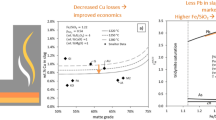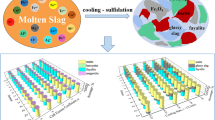Abstract
Effective extraction of copper from sulfide ores requires careful operation of a copper smelter, which in turn depends very much on chemistry of the feed and resulted slag and matte. For example, chemical composition of copper smelting slags has to be in a certain range to ensure that their properties are within specific limits. Disobeying these rules may lead to complications in smelting operation, poor quality of the copper products, and premature shutdown of the copper smelter. In the present paper the microstructure and phase composition of slags from the Almalyk copper flash smelter were investigated experimentally and then modeled thermodynamically to evaluate potential ways of improvement and optimization of the copper smelting process and its products. The slag samples were taken at different stages of the copper smelting process: on slag tapping, after slag transportation to a deposition site, and at the site. Experimental investigation included the XRD, XRF, and SEM techniques, which were also confirmed by the traditional wet chemistry analysis. Thermodynamic modeling was carried out using thermochemical software package MTDATA, which enables thermodynamic and physical properties of the matte, slag, and gas phases to be calculated in a wide range of temperatures, pressures, and chemical compositions. In addition, slag viscosities and corresponding matte settling rates were estimated using the modified Urbain and Utigard–Warczok models, and the Hadamard–Rybczynski equation, respectively. It was found that the copper content in the slags may vary significantly depending on the location of slag sampling. Cu was found to be present as sulfide particles, almost no Cu was found to be dissolved in the slag. Analysis of microstructure and phase composition showed that major phase found in the samples is fayalite, while other phases are complex spinels (based on magnetite), different sulfides, and a glass-like phase. Thermodynamic calculations demonstrated the presence of these phases, their compositions, and optimal ranges of operating conditions. Potential ways of improving the matte grade and optimizing the smelting process were suggested on the basis of the calculations.



























Similar content being viewed by others
References
H. Jalkanen, J. Vehvilainen, and J. Poijarvi: Scand. J. Metall., 2003, vol. 32, pp. 65–70.
R.H. Davies, A.T. Dinsdale, J.A. Gisby, J.A.J. Robinson, and S.M. Martin, CALPHAD, 2002, vol. 26, pp. 229–71.
The International Centre for Diffraction Data: PDF-2 Database, Release 2014. http://www.icdd.com/products/pdf2.htm, 2014. Accessed 16 Nov 2015.
M.E. Schlesinger, M.J. King, K.C. Sole, and W.G. Davenport: Extractive Metallurgy of Copper, 5th ed., Elsevier, ISBN 978-0-08-096789-9, 2011, pp. 1–455.
S. Vaisburd, A. Berner, D.G. Brandon, S. Kozhakhmetov, E. Kenzhaliyev, and R. Zhalelev, Metall. Mater. Trans. B, 2003, vol. 33B, pp. 551–59.
Kondratiev, A., Jak, E, Metall. Mater. Trans. B, 2001, vol. 32B, pp. 1015-25.
Forsbacka, L.; Holappa, L.; Kondratiev, A.; Jak, E., Steel Res. Int., 2007, vol. 78(9), pp. 676–84.
T.A. Utigard and A. Warczok: Proceedings of COPPER 95—COBRE 95 International Conference, vol. 4, W.J. Chen, C. Diaz, A. Luraschi, and P.J.Mackey, eds., Metallurgical Society of CIM, 1995, pp. 423–37.
P. Coursol, N.C. Valencia, P. Mackey, S. Bell, and B. Davis, JOM, 2012, DOI: 10.1007/s11837-012-0454-6.
Acknowledgments
The work was carried out with financial support from JSC Almalyk GMK and from the Ministry of Education and Science of the Russian Federation in the framework of Increase Competitiveness Program of NUST MISIS (No. K2-2014-014) and of the basic part of the state program Organisation of the Research Work for higher educational institutions in 2014–2016.
Author information
Authors and Affiliations
Corresponding author
Additional information
Manuscript submitted December 25, 2015.
Rights and permissions
About this article
Cite this article
Starodub, K., Kuminova, Y., Dinsdale, A. et al. Experimental Investigation and Modeling of Copper Smelting Slags. Metall Mater Trans B 47, 2904–2918 (2016). https://doi.org/10.1007/s11663-016-0761-3
Published:
Issue Date:
DOI: https://doi.org/10.1007/s11663-016-0761-3




